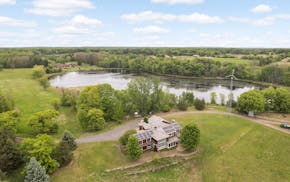The first batch of sustainable aviation fuel made from Minnesota- and North Dakota-grown crops arrived at Minneapolis-St. Paul International Airport on Tuesday, a landmark in efforts to reduce air emissions.
And Wednesday afternoon, that camelina-based fuel helped power its first flight — a 4 p.m. takeoff for a 7:30 p.m. arrival in New York during the city's climate week. Delta Air Lines, the flight's operator, aims to one day make MSP the first airport where all of its flights use sustainable aviation fuel (SAF).
The Minnesota SAF Hub, a coalition led by Greater MSP, orchestrated this as part of its larger mission to decarbonize the airline industry, which accounts for about 2% of the world's emissions of carbon dioxide, according to the U.S. Department of Energy.
"This initial SAF delivery is another example of how we are making SAF real in Minnesota and showing the world how to do it right," said Peter Frosch, president and CEO of Greater MSP, in a news release. "We are highlighting the first SAF flight from MSP International as another major milestone in our push to build a SAF economy anchored in Minnesota."
Farmers in Minnesota and North Dakota partnered with Minnetonka-based Cargill to produce 2,000 acres of winter camelina, a cover crop. The crop, planted in the fall and harvested in the summer, has oil-rich seeds that produce SAF when crushed and refined. Because camelina can grow in rotation with other crops, farmers do not need to displace food crops to grow it.
Cargill processed the camelina, harvested this summer, at a plant in West Fargo and transported about 25,000 gallons of camelina oil to Montana via railcar for blending into SAF. By late 2025, a facility in Pine Bend will blend the SAF locally.
Half a bushel of camelina processes into one gallon of oil, which roughly produces one gallon of the SAF blending component, according to Michael Wojciechowski, director of commercial optimization at SAF-maker Montana Renewables.
SAF made up about 32% of the blended fuel in Delta's flight Wednesday. The flight used about 2,300 gallons of the 7,000 gallons of blended SAF delivered to MSP.
"This first batch of camelina SAF is a demonstration of how we plan to decarbonize air travel and improve water quality on agricultural lands while providing new income sources for farmers in and around Minnesota," Frosch said in the release.
Anne Schwagerl, vice president of the Minnesota Farmers Union, participated in this year's pilot program and grew 75 acres of camelina. In a difficult growing season, she produced about 700 pounds per acre, 300 pounds less than she expected.
"I think everyone in ag has a role to play in this new climate-smart ecosystem that's emerging," Schwagerl said.
Not everyone, though, is convinced SAF is an environmental solution.
Each year, Atlanta-based Delta said it burns through about 250 million gallons of fuel at MSP, its second-biggest hub. Greater MSP, citing International Air Transport Association research, said when combined with jet fuel, SAF can reduce lifecycle carbon emissions from jet fuel by up to 80%.
Jason Hill, a biofuels expert and professor at the University of Minnesota, called that figure "nonsense" and said SAF could actually increase emissions when considering its full lifecycle from producing to using.
"This is just flagrant greenwashing," Hill said. "There are other options, such as not flying or flying more efficiently, that are where we need to go."
Frosch argued Wednesday there are more people flying, and this is a Minnesota-made "innovation to solve a global problem that must be solved."
Nicholas Jordan, co-director of the University's Forever Green Initiative, said he knows SAF's carbon impact is debatable, but camelina offers a range of other benefits, including supporting wildlife, limiting soil erosion and preventing nutrient runoff.
"We think there's no question that there's a strong value proposition for society," Jordan said, "that is well beyond carbon."
Caleb.Fravel@startribune.com is a University of Minnesota student reporter on assignment for the Star Tribune.

Minnesota Department of Health rescinds health worker layoffs

Eco-friendly house on 30 acres near Marine on St. Croix listed at $1.6M

DOGE cuts federal money for upgrades at Velveeta plant in New Ulm
